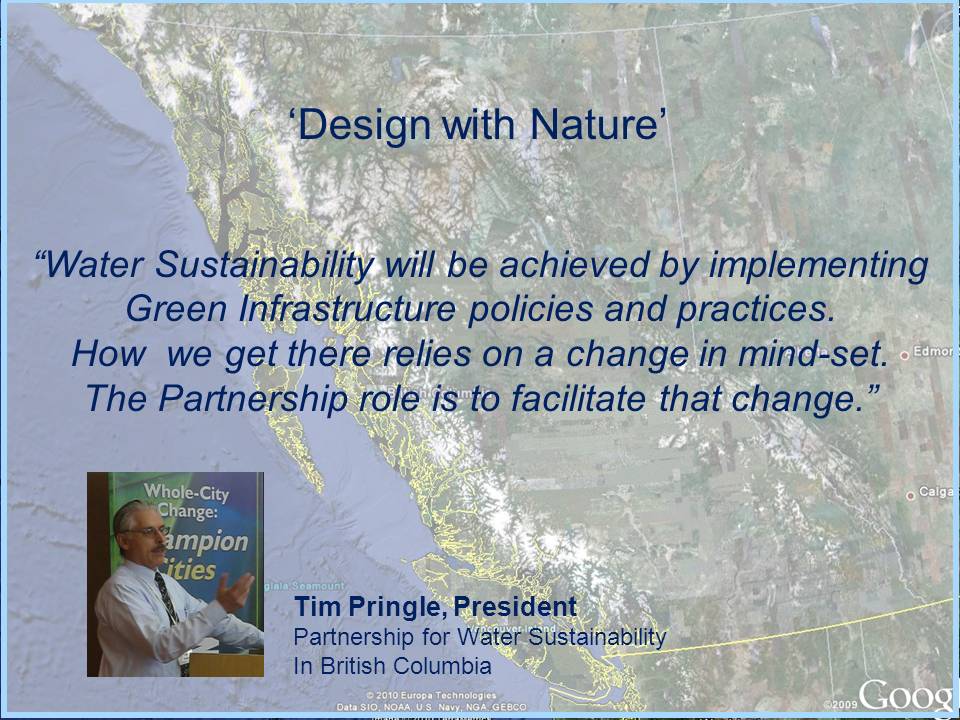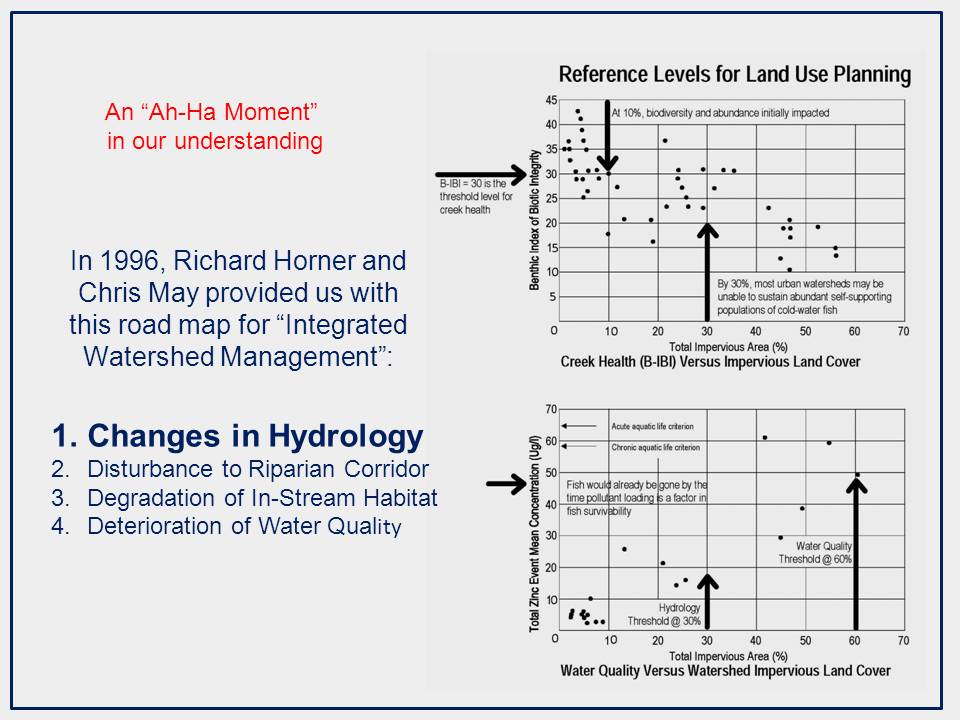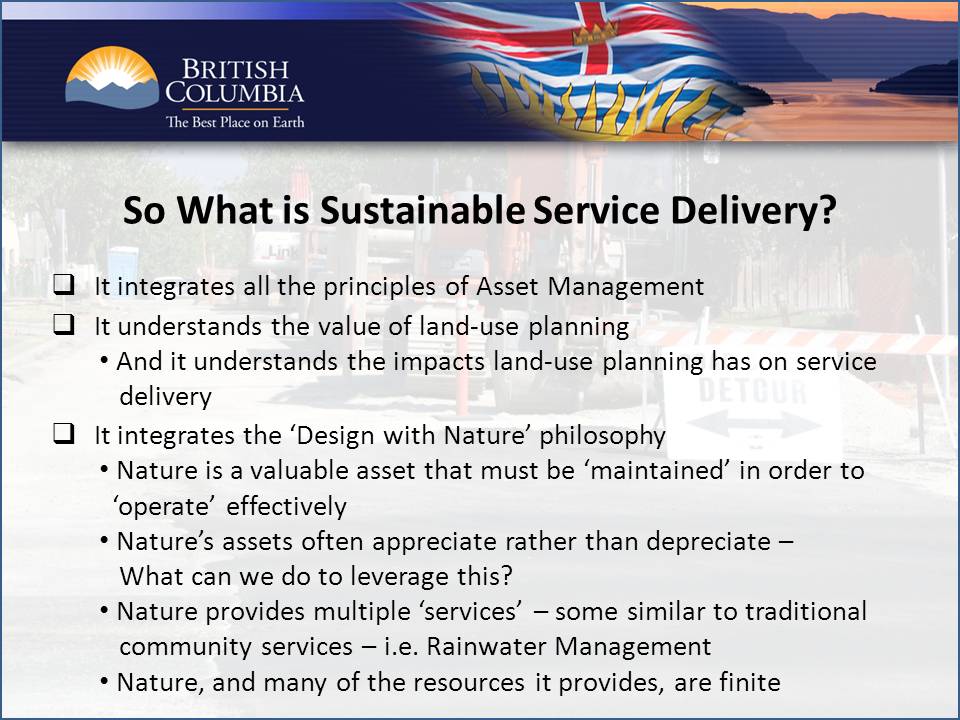FLASHBACK TO 2011: “Rainwater Management in a Watershed Context – What’s the Goal?” published as the conclusion to a green infrastructure series by Stormwater Magazine
Note to Reader:
In 2010-2011, the US-based Stormwater Magazine published the Green Infrastructure & Community Design Series. The last in the series elaborated on the collaborative and science-based process that is unfolding in British Columbia. Titled Rainwater Management in a Watershed Context – What’s the Goal?, the article quotes those who are leading change in practice in British Columbia.
Green Infrastructure & Community Design
In both Canada and the United States, there is a growing green infrastructure movement. This reflects a heightened public awareness of the need to build communities differently. Also, land use and infrastructure professionals increasingly appreciate that effective green infrastructure is at the heart of responsible rainwater management. In British Columbia, a collaborative and science-based process is unfolding. A key message is this:
A science-based understanding of the rainfall-runoff process is the foundation for designing with nature and implementing green infrastructure that is truly effective in protecting watershed and stream health.
“This latest article by Kim Stephens and Jim Dumont makes important comparisons between stormwater management in the US and Canada. Although both are moving  toward greater use of green infrastructure, the differences in approach are significant. I believe it’s important to consider the context in which decisions about water quality are made, and practitioners in the US can learn a great deal from BC’s approach,” stated Janice Kaspersen, Editor of Stormwater Magazine.
toward greater use of green infrastructure, the differences in approach are significant. I believe it’s important to consider the context in which decisions about water quality are made, and practitioners in the US can learn a great deal from BC’s approach,” stated Janice Kaspersen, Editor of Stormwater Magazine.
To Learn More:
Download Rainwater Management in a Watershed Context – What’s the Goal? (by Kim Stephens and Jim Dumont, November 2011).
Visit Stormwater Magazine publishes “Green Infrastructure and Community Design Series” for the list of articles that preceded the one by Stephens and Dumont.
The View from British Columbia
“Looking back, 2008 was a defining year for green infrastructure on Canada’s west coast. The government of British Columbia put in place a policy framework that is a  ‘call to action’ on the part of local governments. This call to action is underpinned by the notion of shared responsibility – that is, everyone needs to understand and care about THE GOAL. If all the players know their role in relation to the goal, then together we can create the future that we all want,” wrote Kim Stephens, Executive Director of the Partnership for Water Sustainability in BC.
‘call to action’ on the part of local governments. This call to action is underpinned by the notion of shared responsibility – that is, everyone needs to understand and care about THE GOAL. If all the players know their role in relation to the goal, then together we can create the future that we all want,” wrote Kim Stephens, Executive Director of the Partnership for Water Sustainability in BC.
What’s the Goal?
“The United States and Canada are culturally different, yet we can learn from each other, and we each can adapt lessons learned by the other. The power of British Columbia’s enabling approach is the ability to leapfrog ahead when the science leads us to a better way. Cross-border sharing between British Columbia and Washington State, for example, has led to breakthroughs in understanding the cause-and-effect relationship between land use change and stream health,” continued Kim Stephens.
“The approach we have taken in British Columbia differs from that of the United States EPA due to the nature of the root problems being solved,” added Jim Dumont. ”The critical issue in British Columbia is the damage and loss of habitat caused by development and erosion of the headwater streams. EPA has focussed upon water  quality in the main stems and coastal waters and seeks to restore the resources of those waters through the goals and objectives of the Clean Water Act.”
quality in the main stems and coastal waters and seeks to restore the resources of those waters through the goals and objectives of the Clean Water Act.”
“Perhaps when the EPA focus shifts from water quality to include habitat loss, then the lessons learned in British Columbia can be reviewed and incorporated into the policies and objectives of the EPA.”
Get the Hydrology Right
In the mid-1990s, Richard Horner and Chris May (of the Center for Urban Water Resources Management at the University of Washington) identified four factors that negatively affect stream health. In rank order they were: (1) Changes in hydrology; (2) Disturbance and/or loss of integrity of riparian corridor; (3) Degradation and/or loss of aquatic habitat within the stream; and (4) Deterioration of water quality.
“The two key messages delivered by this research was that (1) fish would already be gone by the time pollutant loading is a factor; and (2) if we get the hydrology right, water quality will typically take care of itself,” emphasized Jim Dumont.
“In BC we will experience an improvement in quality while maintaining the headwater stream health which includes BOTH hydrology AND quality. This appears to be a more balanced approach while providing greater benefits.”
Achieve More With Less
The approach to rainwater management and green infrastructure in British Columbia is rooted in an underlying environmental ethic. Now, the impact of the new fiscal reality is providing an additional driver for designing with nature:
The initial capital cost of municipal infrastructure is about 20% of the life-cycle cost; the other 80% largely represents a future unfunded liability.
“Each year, the funding shortfall grows. As infrastructure ages and fails, local governments cannot keep up with renewal and/or replacement. Thus, fiscal constraints provide a powerful impetus for doing business differently. Green infrastructure is part of a holistic approach to ‘achieve more with less’, especially since local governments bear  the entire financial burden to stabilize and restore watercourses impacted by the cumulative impacts of increased rainwater runoff volume,” stated Glen Brown. Formerly the Executive Director of the Local Government Infrastructure and Finance Division, he is now the General Manager (Victoria Operations) for the Union of British Columbia Municipalities.
the entire financial burden to stabilize and restore watercourses impacted by the cumulative impacts of increased rainwater runoff volume,” stated Glen Brown. Formerly the Executive Director of the Local Government Infrastructure and Finance Division, he is now the General Manager (Victoria Operations) for the Union of British Columbia Municipalities.
Sustainable Service Delivery
“Sustainable Service Delivery is the Province of British Columbia’s branding for a life-cycle way of thinking about infrastructure needs and how to pay for them over time. The approach is holistic. We are challenging local governments to think about what asset management entails BEFORE the asset is built. The paradigm-shift starts with land use planning and determining what services can be provided sustainably, both fiscally and ecologically,” continued Glen Brown.
“The legislative authority for integration of land use planning and asset management, including financial management, already exists. Local governments can develop a truly integrated Asset Management Strategy that views the watershed though an environmental lens.”
“The Province’s Living Water Smart and Green Communities initiatives are catalysts for ‘designing with nature’: Start with effective green infrastructure and protect environmental values. Get the watershed vision right. Then create a blueprint to implement green infrastructure,” concluded Glen Brown.
To Learn More:
Download Rainwater Management in a Watershed Context – What’s the Goal?, the article co-authored by Kim Stephens and Jim Dumont.





